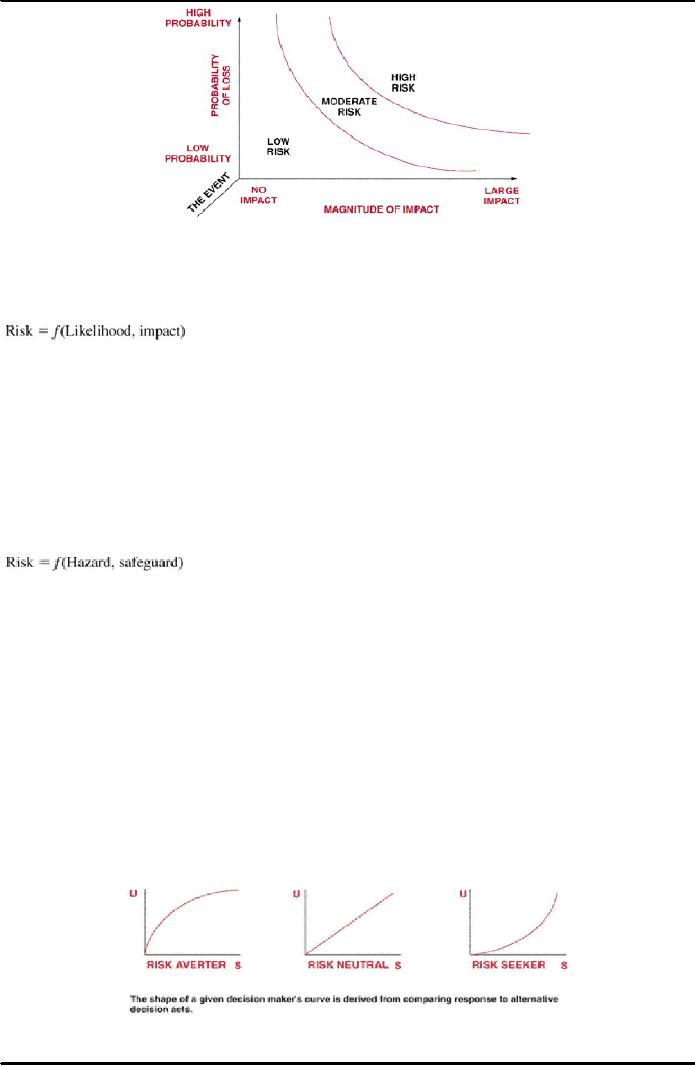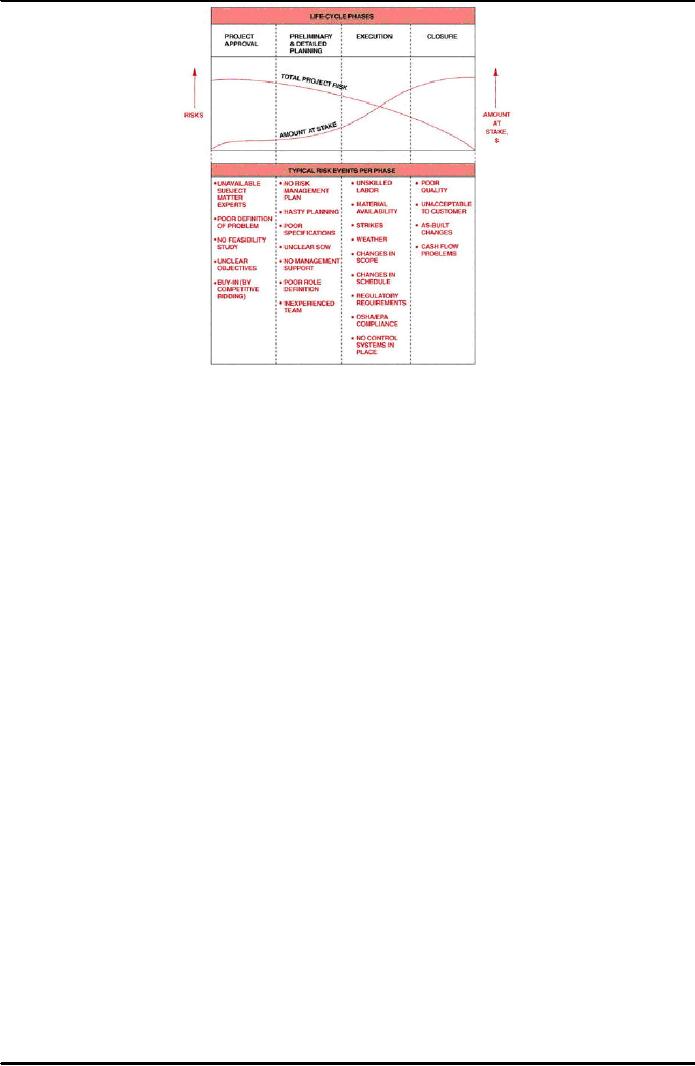 |

Project
Management MGMT627
VU
LESSON
44
PROJECT
RISK MANAGEMENT
BROAD
CONTENTS
What
is Risk?
Primary
Components
Tolerance
of Risk
Risk
Management
Categories
of Risk
Risk
Planning
Risk
Identification
Risk
Assessment (identification and
analysis)
Risk
Handling
In
the early days of project
management on many commercial programs,
the majority of project
decisions
heavily favored cost and
schedule. This favoritism occurred
because we knew more about
cost
and
scheduling than we did about
technical risks. Technology forecasting
was very rarely
performed
other
than by extrapolating past
technical knowledge into the
present.
Today,
the state of the art of technology
forecasting is being pushed to the
limits. For projects with
time
duration
of less than one year, we
normally assume that the
environment is known and stable,
particularly
the technological environment. For
projects over a year or so in length,
technology
forecasting
must be considered. Computer technology
doubles in performance about every two
years.
Engineering
technology is said to double
every three or so years. How
can a project manager
accurately
define
and plan the scope of a three- or
four-year project without
expecting engineering
changes
resulting
from technology improvements?
44.1
What
are the Risks?
A
Midwest manufacturing company embarked on an
eight-year project to design the
manufacturing
factory
of the future. The plant is
scheduled to go into the construction
phase in the year 2000. How
do
we
design the factory of the future without
forecasting the technology? What computer
technology will
exist?
What types of materials will exist and
what types of components will
our customers
require?
What
production rate will we need and
will technology exist to support
this production
level?
Economists
and financial institutions forecast
interest rates. The forecasts
appear in public
newspapers
and
journals. Yet, every company
involved in high tech does
some form of technology
forecasting, but
appears
very reluctant to publish the data.
Technology forecasting is regarded as company
proprietary
information
and may be part of the company's
strategic planning process.
We
read in the newspaper about
cost overruns and schedule slips on a
wide variety of large-scale
development
projects. Several issues within the
control of the buyer, seller, or
major stakeholders can
lead
to cost growth and schedule
slippage on development projects. These
causes include, but are
not
limited
to:
�
Starting a project with a
budget and/or schedule that
is inadequate for the desired level
of
performance
or scope (e.g., integration
complexity).
�
Having an overall development
process (or key parts of
that process) that favors
performance
(or
scope) over cost and
schedule.
�
Establishing a design that is near
the feasible limit of achievable
performance or integration
complexity
at a given point in
time.
�
Making major project design
decisions before the relationships between
cost, performance,
schedule,
and risk are understood.
352

Project
Management MGMT627
VU
These
four causes will contribute
to uncertainty in forecasting technology
and the associated design
needed
to meet performance requirements. And the
inability to perfectly forecast
technology and the
associated
design will contribute to a project's
technical risk, and can also
lead to cost and schedule
risk.
Today,
the competition for technical achievement
has become fierce. Companies have gone
through
life-cycle
phases of centralizing all
activities, especially management
functions, but are
decentralizing
technical
expertise. By the mid 1980s, many
companies recognized the need to
integrate technical risks
with
cost and schedule risks, and
other activities (e.g., quality).
Risk management processes
were
developed
and implemented where risk
information was made
available to key decision-makers.
The
risk management process,
however, should be designed to do more
than just identify the
risk.
The
process must also include: a
formal planning
activity,
analysis
to
quantify the likelihood and
predict
the
impact on the project, a handling
strategy
for selected risks, and the ability to
monitor
the
progress
in
reducing these selected risks to the
desired level.
A
project, by definition, is something that
we have not done previously and will
not do again in the
future.
Because of this uniqueness, we have
developed a ''live with it"
attitude on risk and attribute it
as
part
of doing business. If risk
management is set up as a continuous,
disciplined process of
planning,
assessment
(identification and analysis), handling, and
monitoring, then the system
will easily
supplement
other systems as organization,
planning and budgeting, and cost
control. Surprises
that
become
problems will be diminished because
emphasis will now be on
proactive rather than
reactive
management.
Risk
management can be justified on almost
all projects. The level of
implementation can vary
from
project
to project, depending on such factors as
size, type of project, who
the customer is, relationship to
the
corporate strategic plan, and corporate
culture. Risk management is
particularly important when
the
overall
stakes are high and a great
deal of uncertainty exists. In the past,
we treated risk as a "let's
live
with
it." Today, risk management
is a key part of overall
project management. It forces us to focus
on
the
future where uncertainty exists and
develop suitable plans of action to
prevent potential issues
from
adversely
impacting the project.
Risk
is a measure of the probability and
consequence of not achieving a
defined project goal.
Most
people
agree that risk involves the
notion of uncertainty. Can the
specified aircraft range be
achieved?
Can
the computer be produced within budgeted cost?
Can the new product launch
date be met? A
probability
measure can be used for
such questions; for example,
the probability of not
meeting the new
product
launch date is 0.15.
However, when risk is considered, the
consequences or damage
associated
with
occurrence must also be
considered.
Goal
A, with a probability of occurrence of
only 0.05, may present a
much more serious (risky)
situation
than
goal B, with a probability of
occurrence of 0.20, if the consequences
of not meeting goal A are,
in
this
case, more than four times more
severe than failure to meet
goal B. Risk is not always
easy to
assess,
since the probability of occurrence
and the consequence of occurrence
are usually not
directly
measurable
parameters and must be estimated by
statistical or other
procedures.
44.2
Components
of Risk
Risk
has two primary components
for a given event:
�
A probability of occurrence of that
event
�
Impact of the event occurring
(amount at stake)
353

Project
Management MGMT627
VU
Figure
44.1: Overall
risk is a function of its
components.
Figure
44.1 shows the components of
risk.
Conceptually,
risk for each event
can be defined as a function of
likelihood and impact; that
is,
In
general, as either the likelihood or
impact increases, so does the
risk. Both the likelihood
and impact
must
be considered in risk management.
Risk
constitutes a lack of knowledge of future
events. Typically, future
events (or outcomes) that
are
favorable
are called opportunities,
whereas unfavorable events
are called risks.
Another
element of risk is the cause of risk.
Something, or the lack of something, can
induce a risky
situation.
We denote this source of danger as the
hazard. Certain hazards can
be overcome to a great
extent
by knowing them and taking action to
overcome them. For example, a large
hole in a road is a
much
greater danger to a driver who is unaware of it
than to one who travels the
road frequently and
knows
enough to slow down and go
around the hole. This leads
to the second representation of
risk:
Risk
increases with hazard but
decreases with safeguard. The
implication of this equation is
that good
project
management should be structured to
identify hazards and to allow
safeguards to be developed to
overcome
them. If enough safeguards are
available, then the risk can
be reduced to an acceptable
level.
44.3
Tolerance
of Risk
There
is no single textbook answer on
how to manage risk. The
project manager must rely
upon sound
judgment
and the use of the appropriate tools in
dealing with risk. The
ultimate decision on how to
deal
with
risk is based in part upon
the project manager's tolerance for
risk.
The
three commonly used classifications of
tolerance for risk appear in
Figure 44.2. They include
the
risk
averter or avoider, the neutral
risk taker, and the risk
seeker or lover. The
Y
axis
in Figure 44.2
represents
"utility," which can be
defined as the amount of satisfaction or
pleasure that the
individual
receives
from a payoff. (This is also
called the project manager's tolerance
for risk.) The X axis
in this
case
is the amount of money at stake.
Figure
44.2: Risk preference &
utility function
354

Project
Management MGMT627
VU
With
the risk averter, utility
rises at a decreasing
rate.
In other words, when more money is at
stake, the
project
manager's satisfaction or tolerance
diminishes. With the risk
lover, the project
manager's
satisfaction
increases when more money is at
stake (i.e., an increasing slope to the
curve). A risk
averter
prefers
a more certain outcome and will demand a
premium to accept
risk.
A
risk lover prefers the more uncertain
outcome and may be willing to
pay a penalty to take a
risk.
44.4
Risk
Management
Risk
management is the act or practice of
dealing with risk. It
includes planning
for
risk, assessing
(identifying
and analyzing)
risk issues, developing
risk
handling options,
and monitoring
risks
to
determine
how risks have changed.
Risk
management is not a separate
project office activity
assigned to a risk management department,
but
rather
is one aspect of sound project
management. Risk management
should be closely coupled
with key
project
processes, including but not
limited to: overall project
management, systems engineering,
cost,
scope,
quality, and schedule.
Proper
risk management is proactive rather
than reactive. As an example, an
activity in a
network
requires that a new
technology be developed. The
schedule indicates six
months for
this
activity, but project engineers
think that nine months is
closer to the truth. If the
project
manager
is proactive, he might develop a
Risk Handling Plan right
now.
If the project manager
is
reactive (e.g., a "problem
solver"), then he will do nothing
until the problem actually
occurs.
At
that time the project
manager must react rapidly to the
crisis, and may have lost
valuable
time
when contingencies could
have been developed. Hence,
proper risk management will
attempt
to reduce the likelihood of an event
occurring and/or the
magnitude of its
impact.
44.5
Categories
of Risk
The
Project Management Institute
categorizes
risks as
follows:
Externalunpredictable:
Government
regulations, natural hazards, and
acts of God
Externalpredictable:
Cost
of money, borrowing rates,
raw material
availability
The
external risks are outside of the
project manager's control
but may affect the direction
of the project.
Internal
(nontechnical): Labor
stoppages, cash flow problems, safety
issues, health and benefit
plans.
The
internal risks may be within the
control of the project
manager and present uncertainty
that may
affect
the project.
Technical:
Changes
in technology, changes in state of the
art, design issues,
operations/maintenance
issues.
Technical risks relate to the utilization
of technology and the impact it has on
the direction of the
project.
Legal:
Licenses,
patent rights, lawsuits, subcontractor performance,
contractual failure
To
identify risk issues, evaluators
should break down program
elements to a level where they
can
perform
valid assessments. The
information necessary to do this varies
according to the phase of the
program.
During the early phases,
requirement and scope documents, and
acquisition plans may be the
only
program-specific data available.
They should be evaluated to
identify issues that may
have adverse
consequences.
Another
method of decomposition is to create a
Work Breakdown Structure (WBS) as
early as possible
in
a program, and use this in a structured
approach to evaluate candidate risk
categories against
candidate
system or lower level
designs. To use this approach,
each element at level three of the WBS
is
further
broken down to the fourth or
fifth level and is subjected to a risk
analysis. Items at system,
segment
or group, or subsystem levels, as
well as management items, are
assessed using attributes
such
as
maturity and complexity of hardware and
software items or the dependency of the item on
existing
systems,
facilities, or contractors to evaluate
their risk levels.
355

Project
Management MGMT627
VU
Another
approach is to evaluate risk associated
with some key processes
(e.g., design and
manufacturing)
that will exist on a
project. Information on this approach is
contained in the government
DoD
directive 4245.7-M, which
provides a standard structure for
identifying technical risk
areas in the
transition
from development to production.
The structure is geared toward
programs that are
mid-to-late
in
the development phase but,
with modifications, could be
used for other projects. The
directive
identifies
a template
for
each major technical
activity. Each template identifies
potential areas of
risk.
Overlaying
each template on a project
allows identification of mismatched
areas, which are
then
identified
as "at risk." Having used
all applicable templates, the program
manager will have created
a
"watch
list" of production transition
risk areas and can
prioritize control actions--
many of which will
be
the responsibility of systems
engineering. DoD Directive
4245.7-M describes technical
methods for
reducing
the risk in each identified
area.
High-risk
areas may reflect missing
capabilities in the project manager's
organization or in supporting
organizations.
They may also reflect
technical difficulties in the design or
development process. In
either
case, "management" of risk
involves using project
management assets to reduce the
identified
risks.
The
value in each of these
approaches to risk identification
lies in the methodical nature of the
approach,
which
forces disciplined, consistent treatment
of risk. However, using any
method in a "cookbook"
manner
may cause unique risk
aspects of the project to be overlooked.
Before acting on the outcome of
any
assessment, the project manager
must review the strengths
and weaknesses of the approach
and
identify
other factors that may
introduce technical, schedule,
cost, program, or other
risks.
Certainty,
Risk, and
Uncertainty
Decision-making
falls into three categories: certainty,
risk, and uncertainty. Decision-making
under
certainty
is the easiest case to work
with. With certainty, we
assume that all of the
necessary
information
is available to assist us in making the
right decision, and we can
predict the outcome with a
high
level of confidence.
Decision-Making
under Certainty
Decision-making
under certainty implies that
we know with 100 percent
accuracy what the states
of
nature
will be and what the expected payoffs
will be for each state of
nature. Mathematically, this can
be
shown
with payoff tables.
To
construct a payoff matrix, we must
identify (or select) the
states of nature over which
we
have no
control.
We then select our own
action to be taken for each
of the states of nature. Our actions are
called
strategies.
The elements in the payoff
table are the outcomes for
each strategy.
A
payoff matrix based on
decision-making under certainty
has two controlling
features.
�
Regardless of which state of nature
exists, there will be one dominant strategy
that will produce
larger
gains or smaller losses than any
other strategy for all the
states of nature.
�
There are no probabilities
assigned to each state of
nature.
Decision-Making
under Risk
In
most cases, there usually
does not exist one
dominant strategy for all
states of nature. In a realistic
situation,
higher profits are usually
accompanied by higher risks and therefore
higher probable
losses.
When
there does not exist a
dominant strategy, a probability
must be assigned to the occurrence of
each
state
of nature.
Risk
can be viewed as outcomes
(i.e., states of nature)
that can be described within
established
confidence
limits (i.e., probability
distributions). These probability
distributions are obtained
from well-
defined
experimental distributions.
Decision-making
under Uncertainty
The
difference between risk and uncertainty
is that under risk there are
assigned probabilities, and
under
uncertainty
meaningful assignments of probabilities
are not possible. As with
decision making under
356

Project
Management MGMT627
VU
risk,
uncertainty also implies
that there may exist no
single dominant strategy.
The decision-maker,
however,
does have at his disposal four
basic criteria from which to
make a management decision.
The
decision
about which criterion to use
will depend on the type of project as
well as the project
manager's
tolerance
to risk.
Risk
Management Process
It
is important that a risk
management strategy is established early in a
project and that risk
is
continually
addressed throughout the project
life cycle. Risk management
includes several related
actions
involving risk: planning,
assessment (identification and analysis),
handling, and monitoring:
�
Risk
planning: This
is the process of developing
and documenting an organized,
comprehensive, and
interactive
strategy and methods for
identifying and tracking risk
issues, developing risk
handling plans,
performing
continuous risk assessments to
determine how risks have changed, and
assigning adequate
resources.
�
Risk assessment: This
process involves identifying and
analyzing program areas and
critical technical
process
risks to increase the likelihood of
meeting cost, performance, and schedule
objectives.
�Risk
identification is the
process of examining the program
areas and each critical
technical process to
identify
and document the associated risk.
Risk
analysis is the
process of examining each
identified risk
issue
or process to refine the description of
the risk, isolate the cause,
and determine the effects.
�
Risk handling: This
is the process that identifies,
evaluates, selects, and implements
options in order
to
set risk at acceptable
levels given program constraints
and objectives. This
includes the specifics on
what
should be done, when it should be
accomplished, who is responsible, and associated
cost and
schedule.
Risk handling options
include assumption, avoidance, control
(also known as mitigation), and
transfer.
The most desirable handling
option is selected, and a
specific approach is then developed
for
this
option.
�
Risk monitoring: This
is the process that systematically
tracks and evaluates the performance of
risk
handling
actions against established metrics throughout the
acquisition process and provides
inputs to
updating
risk handling strategies, as
appropriate.
44.6
Risk
Planning
Risk
planning is the detailed formulation of a
program of action for the
management of risk. It is the
process
to:
�
Develop and document an organized,
comprehensive, and interactive risk
management strategy.
�
Determine the methods to be used to
execute a program's risk management
strategy.
�
Plan for adequate
resources.
Risk
planning is iterative and includes the
entire risk management
process, with activities to
assess
(identify
and analyze), handle, monitor
(and document) the risk associated
with a program. The result
is
often
the risk management plan
(RMP).
Planning
begins by developing and documenting a
risk management strategy.
Early efforts establish the
purpose
and objective, assign responsibilities
for specific areas, identify
additional technical expertise
needed,
describe the assessment process
and areas to consider,
define a risk rating approach,
delineate
procedures
for consideration of handling
options, establish monitoring metrics
(where possible), and
define
the reporting, documentation, and
communication needs.
The
RMP is the roadmap that tells the
project team how to get from
where the program is today to
where
the program manager wants it to be in the
future. The key to writing a
good RMP is to
provide
the
necessary information so the program
team knows the objectives, goals, and the
risk management
process.
Since it is a roadmap, it may be specific in
some areas, such as the
assignment of
responsibilities
for project personnel and
definitions, and general in other areas
to allow users to
choose
the
most efficient way to proceed.
For example, a description of techniques
that suggests several
methods
for evaluators to use to assess
risk is appropriate, since
every technique has
advantages and
disadvantages
depending on the situation.
357

Project
Management MGMT627
VU
44.7
Risk
Assessment
Risk
assessment is the problem
definition stage
of risk management, the stage
that identifies,
analyzes,
and
quantifies program issues in
terms of probability and
consequences, and possibly
other
considerations
(e.g., the time to impact). The
results are a key input to
many subsequent risk
management
actions. It is often a difficult and
time-consuming part of the risk
management process.
There
are no quick answers or
shortcuts. Tools are
available to assist evaluators in
assessing risk, but
none
are totally suitable for
any program and are often
highly misleading if the user
does not understand
how
to apply them or interpret the results.
Despite its complexity, risk
assessment is one of the
most
important
phases of the risk management
process because the caliber
and quality of assessments
can
have
a large impact on program
outcomes.
The
components of assessment-- identification
and analysis-- are performed
sequentially with
identification
being the first step.
Risk
identification begins by compiling the program's
risk issues. Project issues
should be examined and
identified
by reducing them to a level of detail
that permits an evaluator to understand the
significance
of
any risk and its causes
(e.g., risk issues). This is a
practical way of addressing the
large and diverse
number
of potential risks that often occur in
moderate- to large-scale programs.
For
example, a WBS level 4 or 5 element
may be made up of several risk
issues associated with
a
specification
or function.
Risk
analysis is a technical and systematic
process to examine identified risks,
isolate causes,
determine
the
relationship to other risks, and express
the impact in terms of probability and
consequence of
occurrence.
44.8
Risk
Identification
The
second step in risk
management is to identify all
potential risk issues. This
may include a survey
of
the
program, customer, and users for
concerns and problems.
Some
degree of risk always exists in
project, technical, test,
logistics, production, and engineering
areas.
Project
risks include cost, funding,
schedule, contract relationships, and
political risks. (Cost and
schedule
risks are often so fundamental to a
project that they may be
treated as stand-alone risk
categories.)
Technical risks, such as related to
engineering and technology, may
involve the risk of
meeting
a performance requirement, but may
also involve risks in the feasibility of
a design concept or
the
risks associated with using
state-of-the-art equipment or software.
Production risk includes
concerns
over
packaging, manufacturing, lead times, and
material availability. Support risks
include
maintainability,
operability, and trainability concerns.
The understanding of risks in these and
other
areas
evolves over time.
Consequently,
risk identification must
continue through all project
phases.
The
methods for identifying risk
are numerous. Common practice is to
classify project risk
according to
its
source. Most sources are
either objective or
subjective.
Objective
sources: Recorded
experience from past projects and the
current project as it
proceeds
�
Lessons learned
files
�
Program documentation
evaluations
�
Current performance data
Subjective
sources: Experiences
based upon knowledgeable
experts
�
Interviews and other data
from subject matter experts
Risks
can also be identified according to
life-cycle phases, as shown in Figure
44.3. In the early
life-
cycle
phases, the total project
risk is high because of lack
of information. In the later life-cycle
phases,
the
financial risk is the
greatest.
358

Project
Management MGMT627
VU
Figure
44.3: Life-cycle
risk analysis
Any
source of information that
allows recognition of a potential
problem can be used for
risk
identification.
These include:
�
Systems engineering
documentation
�
Life-cycle cost analysis
�
Plan/WBS decomposition
�
Schedule analysis
�
Baseline cost estimates
�
Requirements documents
�
Lessons learned
files
�
Assumption analysis
�
Trade studies/analyses
�
Technical performance measurement
(TPM) planning/analysis
�
Models (influence diagrams)
�
Decision drivers
�
Brainstorming
�
Expert judgment
Expert
judgment techniques are applicable
not only for risk
identification, but also for
forecasting and
decision-making.
Two expert judgment techniques
are the Delphi method and the
nominal group
technique.
The Delphi method has the
following general steps:
Step
1: A
panel of experts is selected from
both inside and outside the
organization. The experts do
not
interact on a face-to-face basis and may
not even know who else
sits on the panel.
Step
2: Each
expert is asked to make an anonymous
prediction on a particular
subject.
Step
3: Each
expert receives a composite feedback of the
entire panel's answers and
is asked to
make
new predictions based upon
the feedback. The process is then
repeated as necessary.
Closely
related to the Delphi method is the
nominal group technique,
which allows for
face-to-face
contact
and direct communication. The
steps in the nominal group
technique are as
follows:
Step
1: A
panel is convened and asked to generate
ideas in writing.
Step
2: The
ideas are listed on a board
or a flip chart. Each idea is
discussed among the panelists.
Step
3: Each
panelist prioritizes the ideas,
which are then ranked
mathematically. Steps 2 and 3
may
be
repeated as necessary.
359

Project
Management MGMT627
VU
Expert
judgment techniques have the potential
for bias in risk
identification and analysis.
Factors
affecting
the bias include:
�
Overconfidence in one's
ability
�
Insensitivity to the problem or
risk
�
Proximity to project
�
Motivation
�
Recent event
recall
�
Availability of time
�
Relationship with other
experts
There
exist numerous ways to classify risks. In
a simple business context,
risk can be defined
as:
�
Business risk
�
Insurable risk
Business
risks provide us with opportunities of
profit and loss. Examples of business
risk would be
competitor
activities, bad weather, inflation,
recession, customer response,
and availability of
resources.
Insurable
risks provide us with only a
chance for a loss. Insurable
risks include such elements
as:
Direct
property damage: This
includes insurance for
assets such as fire insurance,
collision insurance,
and
insurance for project materials,
equipment, and properties.
Indirect
consequential loss: This
includes protection for contractors
for indirect losses due to
third
party
actions, such as equipment replacement and debris
removal.
Legal
liability: This
is protection for legal
liability resulting from
poor product design, design
errors,
product
liability, and project performance
failure. This does not
include protection from loss
of
goodwill.
Personnel:
This
provides protection resulting
from employee bodily injury
(worker's compensation),
loss
of key employees, replacement cost of key
employees, and several other types of
business losses
due
to employee actions.
On
construction projects, the owner/customer usually
provides ''wrap-up" or "bundle"
insurance, which
bundles
the owner, contractor, and subcontractors
into one insurable package.
The contractor may be
given
the responsibility to provide the bundled
package, but it is still
paid for by the
owner/customer.
44.9
Risk
Handling
Risk
handling includes specific
methods and techniques to deal with
known risks, identifies who
is
responsible
for the risk issue, and
provides an estimate of the cost and
schedule associated with
reducing
the
risk, if any. It involves
planning and execution with the
objective of reducing risks to an
acceptable
level.
The evaluators who assess
risk should begin the
process by identifying risks and
developing
handling
options and approaches to propose to the
program manager, who selects the
appropriate one(s)
for
implementation. There are several factors
that can influence our
response to a risk, including
but not
limited
to:
�
Amount
and quality of information on the actual
hazards that caused the risk
(descriptive
uncertainty)
�
Amount
and quality of information on the
magnitude of the damage (measurement
uncertainty)
�
Amount
and quality of information on probability
of occurrence
�
Personal
benefit to project manager
for accepting the risk (voluntary
risk)
�
Risk
forced upon project manager
(involuntary risk)
�
Confusion
and avoidability of the risk
�
The
existence of cost-effective alternatives
(equitable risks)
�
The
existence of high-cost alternatives or
possibly lack of options
(inequitable risks)
�
Length
of exposure to the risk
Risk
handling must be compatible
with the RMP and any
additional guidance the program
manager
provides.
A critical part of risk
handling involves refining and selecting
the most appropriate
handling
360

Project
Management MGMT627
VU
option(s)
and specific approach (es)
for selected risk issues
(often those with medium or
higher risk
levels).
Personnel
who evaluate candidate risk
handling options may use
the following criteria as
starting points
for
evaluation:
�
Can the option be feasibly
implemented and still meet the
user's needs?
�
What is the expected effectiveness of the
handling option in reducing
program risk to an
acceptable
level?
�
Is the option affordable in terms
of dollars and other resources (e.g.,
use of critical materials,
and
test facilities)?
�
Is time available to develop and
implement the option, and what
effect does that have on
the
overall
program schedule?
�
What effect does the
option have on the system's technical
performance?
Risk
handling options include:
risk assumption, risk avoidance,
risk control, and risk
transfer.
Although
the control option (often
called mitigation) is commonly
used in many high
technology
programs,
it should not automatically be
chosen. All four options
should be evaluated, and the best
one
chosen
for each risk
issue.
The
options for handling risk
fall into the following
categories:
Risk
assumption (i.e., retention): The
project manager says, ''I
know the risk exists and am aware of
the
possible
consequences. I am willing to wait and
see what happens. I accept
the risk and its
impact
should
it occur."
Risk
avoidance: The
project manager says, "I
will not accept this
option because of the
potentially
unfavorable
results."
Risk
control (i.e., prevention or mitigation):
The
project manager says, "I
will take the
necessary
measures
required to control this
risk by continuously reevaluating it and
developing contingency plans
or
fall-back positions. I will do
what is expected."
Risk
transfer: The
project manager says, "I
will share this risk
with others through
insurance or a
warranty,
or transfer the entire risk to them.
Perhaps I can convert the
risk into an
opportunity."
361
Table of Contents:
- INTRODUCTION TO PROJECT MANAGEMENT:Broad Contents, Functions of Management
- CONCEPTS, DEFINITIONS AND NATURE OF PROJECTS:Why Projects are initiated?, Project Participants
- CONCEPTS OF PROJECT MANAGEMENT:THE PROJECT MANAGEMENT SYSTEM, Managerial Skills
- PROJECT MANAGEMENT METHODOLOGIES AND ORGANIZATIONAL STRUCTURES:Systems, Programs, and Projects
- PROJECT LIFE CYCLES:Conceptual Phase, Implementation Phase, Engineering Project
- THE PROJECT MANAGER:Team Building Skills, Conflict Resolution Skills, Organizing
- THE PROJECT MANAGER (CONTD.):Project Champions, Project Authority Breakdown
- PROJECT CONCEPTION AND PROJECT FEASIBILITY:Feasibility Analysis
- PROJECT FEASIBILITY (CONTD.):Scope of Feasibility Analysis, Project Impacts
- PROJECT FEASIBILITY (CONTD.):Operations and Production, Sales and Marketing
- PROJECT SELECTION:Modeling, The Operating Necessity, The Competitive Necessity
- PROJECT SELECTION (CONTD.):Payback Period, Internal Rate of Return (IRR)
- PROJECT PROPOSAL:Preparation for Future Proposal, Proposal Effort
- PROJECT PROPOSAL (CONTD.):Background on the Opportunity, Costs, Resources Required
- PROJECT PLANNING:Planning of Execution, Operations, Installation and Use
- PROJECT PLANNING (CONTD.):Outside Clients, Quality Control Planning
- PROJECT PLANNING (CONTD.):Elements of a Project Plan, Potential Problems
- PROJECT PLANNING (CONTD.):Sorting Out Project, Project Mission, Categories of Planning
- PROJECT PLANNING (CONTD.):Identifying Strategic Project Variables, Competitive Resources
- PROJECT PLANNING (CONTD.):Responsibilities of Key Players, Line manager will define
- PROJECT PLANNING (CONTD.):The Statement of Work (Sow)
- WORK BREAKDOWN STRUCTURE:Characteristics of Work Package
- WORK BREAKDOWN STRUCTURE:Why Do Plans Fail?
- SCHEDULES AND CHARTS:Master Production Scheduling, Program Plan
- TOTAL PROJECT PLANNING:Management Control, Project Fast-Tracking
- PROJECT SCOPE MANAGEMENT:Why is Scope Important?, Scope Management Plan
- PROJECT SCOPE MANAGEMENT:Project Scope Definition, Scope Change Control
- NETWORK SCHEDULING TECHNIQUES:Historical Evolution of Networks, Dummy Activities
- NETWORK SCHEDULING TECHNIQUES:Slack Time Calculation, Network Re-planning
- NETWORK SCHEDULING TECHNIQUES:Total PERT/CPM Planning, PERT/CPM Problem Areas
- PRICING AND ESTIMATION:GLOBAL PRICING STRATEGIES, TYPES OF ESTIMATES
- PRICING AND ESTIMATION (CONTD.):LABOR DISTRIBUTIONS, OVERHEAD RATES
- PRICING AND ESTIMATION (CONTD.):MATERIALS/SUPPORT COSTS, PRICING OUT THE WORK
- QUALITY IN PROJECT MANAGEMENT:Value-Based Perspective, Customer-Driven Quality
- QUALITY IN PROJECT MANAGEMENT (CONTD.):Total Quality Management
- PRINCIPLES OF TOTAL QUALITY:EMPOWERMENT, COST OF QUALITY
- CUSTOMER FOCUSED PROJECT MANAGEMENT:Threshold Attributes
- QUALITY IMPROVEMENT TOOLS:Data Tables, Identify the problem, Random method
- PROJECT EFFECTIVENESS THROUGH ENHANCED PRODUCTIVITY:Messages of Productivity, Productivity Improvement
- COST MANAGEMENT AND CONTROL IN PROJECTS:Project benefits, Understanding Control
- COST MANAGEMENT AND CONTROL IN PROJECTS:Variance, Depreciation
- PROJECT MANAGEMENT THROUGH LEADERSHIP:The Tasks of Leadership, The Job of a Leader
- COMMUNICATION IN THE PROJECT MANAGEMENT:Cost of Correspondence, CHANNEL
- PROJECT RISK MANAGEMENT:Components of Risk, Categories of Risk, Risk Planning
- PROJECT PROCUREMENT, CONTRACT MANAGEMENT, AND ETHICS IN PROJECT MANAGEMENT:Procurement Cycles